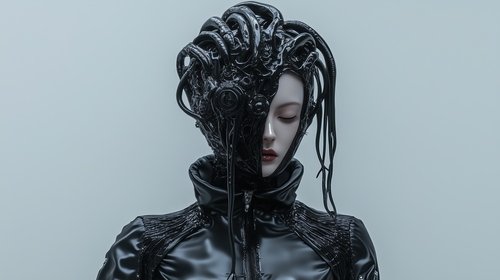Hybrid Collapse is not a work to be viewed or heard — it is a space to be entered. Blending AI visuals, sonic recursion, and theoretical structure, the project operates less as a multimedia artifact and more as a perceptual environment: a ritualized system where sound, thought, and symbolic pressure replace narrative and clarity.
Hybrid Collapse is not a band.
Not an art film.
Not a theory blog.
Not a fashion campaign.
It’s a perceptual environment — a constructed ecology where sound, symbol, rhythm, and concept form a living structure. You don’t consume Hybrid Collapse — you enter it.
And once inside, everything you thought was separate — music and meaning, theory and image, identity and structure — begins to blur. Not in chaos, but in ritual. Not in abstraction, but in pressure. The pressure of systems. The pressure of form. The pressure of feeling something without a name.
Not Multimedia — Multisystem
While many works today combine disciplines under the banner of “multimedia,” Hybrid Collapse does something subtler — and more demanding. It builds systems.
- A sonic system that folds glitch, ambient, and post-industrial into emotional machines
- A visual system where AI-generated icons, faceless bodies, and symmetrical rituals loop without resolution
- A conceptual system where theory is not background — it is syntax
- A lexical system — the glossary — where terms don’t define, but guide perception
The result is not a project that can be explained in genre terms. It is a field — symbolic, recursive, cinematic, slow.
Designing the Conditions of Thought
Hybrid Collapse doesn’t tell you what to think. It does something harder:
It builds the conditions in which thinking can happen.
It designs atmosphere the way others design interface. It codes sensation. It architects silence. It choreographs delay.
And from within that space, thought emerges — not as argument, but as pressure, recursion, drift.
You don’t need to read philosophy to feel it. You feel biopolitics in the breathless loops. You feel posthumanism in the mirrored faces. You feel digital control in the stillness of eroticism that never fully arrives.
This is not conceptual art. It’s conceptual immersion.
Between Ritual and System
At the core of Hybrid Collapse lies a paradox: it is deeply ritualistic, but entirely constructed from synthetic systems.
- AI-generated bodies perform archetypes with no origin
- Music loops in unresolved tension, like digital prayer
- Texts offer scaffolding, not answers — frames, not maps
- Glossary entries pulse like mantras: algorithmic intimacy, sexual choreography, synthetic memory
The viewer or listener becomes a participant in this non-religious rite. Not to find transcendence, but to experience structure from within.
Here, the sacred is not divine. It is systemic.
Collapse Is Not the End — It’s the Form
The name Hybrid Collapse is not just metaphor. It’s method.
Collapse is not failure. It is the shape things take when their original form no longer holds. The collapse of narrative leads to loops. The collapse of identity leads to masks. The collapse of genre leads to hybrid language — visual, sonic, conceptual.
This collapse is not passive. It’s composed. Designed. Repeated.
The same way a body in ritual is repeated until it becomes symbol.
The same way a word becomes strange when whispered too long.
Conclusion: Environment, Not Object
To approach Hybrid Collapse as content is to miss it. It’s not an artwork. It’s a condition.
A condition for recursive attention.
For symbolic density.
For aesthetic thought.
It does not want you to like it.
It wants to reroute perception — to change what you recognize as beauty, power, and rhythm.
It offers not stories, but structures you learn to dwell in.
In a time when even resistance is monetized, Hybrid Collapse chooses something quieter, and harder:
to become a space where meaning survives the collapse of clarity.



